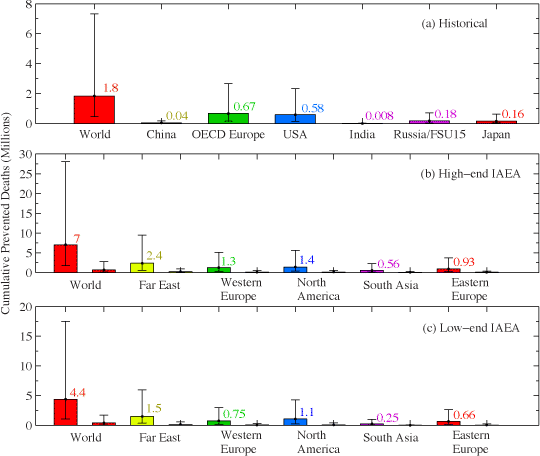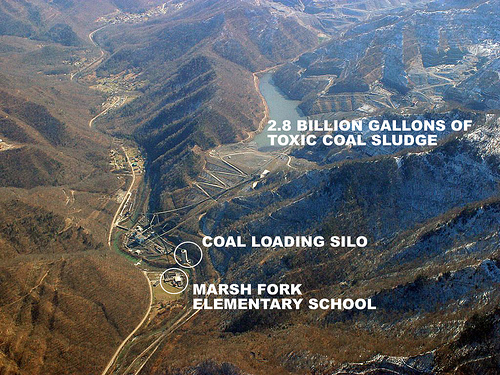How about NASA?
Coal and gas are far more harmful than nuclear power
By Pushker Kharecha and James Hansen,
NASA Goddard Space Flight Center
Human-caused climate change and air pollution remain major global-scale problems and are both due mostly to fossil fuel burning. Mitigation efforts for both of these problems should be undertaken concurrently in order to maximize effectiveness. Such efforts can be accomplished largely with currently available low-carbon and carbon-free alternative energy sources like nuclear power and renewables, as well as energy efficiency improvements.
 Figure 1. Cumulative net deaths prevented assuming nuclear power replaces fossil fuels. The top panel (a) shows results for the historical period in our study (1971-2009), with mean values (labeled) and ranges for the baseline historical scenario. The middle (b) and bottom (c) panels show results for the high-end and low-end projections, respectively, of nuclear power supply estimated by the IAEA (ref. 4) for the period 2010-2050. Error bars reflect the ranges for the fossil fuel mortality factors listed in Table 1 of our paper. The larger columns in panels (b) and (c) reflect the all-coal case and are labeled with their mean values, while the smaller columns reflect the all-gas case; values for the latter are not shown because they are all simply a factor of about 10 lower (reflecting the order-of-magnitude difference between the mortality factors for coal and gas). Countries/regions are arranged in descending order of CO2 emissions in recent years. FSU15=15 countries of the Former Soviet Union and OECD=Organization for Economic Cooperation and Development.
Figure 1. Cumulative net deaths prevented assuming nuclear power replaces fossil fuels. The top panel (a) shows results for the historical period in our study (1971-2009), with mean values (labeled) and ranges for the baseline historical scenario. The middle (b) and bottom (c) panels show results for the high-end and low-end projections, respectively, of nuclear power supply estimated by the IAEA (ref. 4) for the period 2010-2050. Error bars reflect the ranges for the fossil fuel mortality factors listed in Table 1 of our paper. The larger columns in panels (b) and (c) reflect the all-coal case and are labeled with their mean values, while the smaller columns reflect the all-gas case; values for the latter are not shown because they are all simply a factor of about 10 lower (reflecting the order-of-magnitude difference between the mortality factors for coal and gas). Countries/regions are arranged in descending order of CO2 emissions in recent years. FSU15=15 countries of the Former Soviet Union and OECD=Organization for Economic Cooperation and Development.
In a recently published paper (ref. 1), we provide an objective, long-term, quantitative analysis of the effects of nuclear power on human health (mortality) and the environment (climate). Several previous scientific papers have quantified global-scale greenhouse gas (GHG) emissions avoided by nuclear power, but to our knowledge, ours is the first to quantify avoided human deaths as well as avoided GHG emissions on global, regional, and national scales.
The paper demonstrates that without nuclear power, it will be even harder to mitigate human-caused climate change and air pollution. This is fundamentally because historical energy production data reveal that if nuclear power never existed, the energy it supplied almost certainly would have been supplied by fossil fuels instead (overwhelmingly coal), which cause much higher air pollution-related mortality and GHG emissions per unit energy produced (ref. 2).
http://climate.nasa.gov/news/903/
Coal and gas are far more harmful than nuclear power
By Pushker Kharecha and James Hansen,
NASA Goddard Space Flight Center
Human-caused climate change and air pollution remain major global-scale problems and are both due mostly to fossil fuel burning. Mitigation efforts for both of these problems should be undertaken concurrently in order to maximize effectiveness. Such efforts can be accomplished largely with currently available low-carbon and carbon-free alternative energy sources like nuclear power and renewables, as well as energy efficiency improvements.

In a recently published paper (ref. 1), we provide an objective, long-term, quantitative analysis of the effects of nuclear power on human health (mortality) and the environment (climate). Several previous scientific papers have quantified global-scale greenhouse gas (GHG) emissions avoided by nuclear power, but to our knowledge, ours is the first to quantify avoided human deaths as well as avoided GHG emissions on global, regional, and national scales.
The paper demonstrates that without nuclear power, it will be even harder to mitigate human-caused climate change and air pollution. This is fundamentally because historical energy production data reveal that if nuclear power never existed, the energy it supplied almost certainly would have been supplied by fossil fuels instead (overwhelmingly coal), which cause much higher air pollution-related mortality and GHG emissions per unit energy produced (ref. 2).
http://climate.nasa.gov/news/903/







